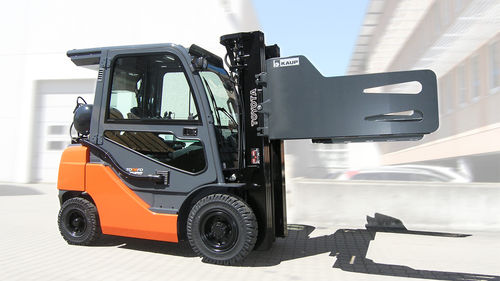with independent sideshift - 2 hydraulic functions
KAUP attachments of the class T413 designed with high visibility are mainly used for in-plant, non-palletised transportation of bales of paper, waste paper, tobacco and textiles or also boxes and containers. Pulp, foamed plastic (polystyrene) wool and Big-Bags can also be transported with specially designed clamping arms.
Qualities:
- Excellent price-performance ratio
- Very good visibility
- Solid strengthened design with KAUP clamp profiles from T-profiles and C- profiles
- Solid slim arm design
- Independent sideshift serially
- Combination with KAUP Rotators possible
- Customer specified modifications feasible
• Bale clamps with higher capacities available upon request.
• Variations in width, opening ranges and arm dimensions available upon request.
• Also available without sideshift, model T403
• Also available with 1 arm oscillating, model T413B-1.
• Special version for Big Bags, based on the KAUP Bale Clamp, are also available.
• Load Backrest see model T179.
Attachment has separate sideshift as standard. The maximum allowable sideshift stroke (e.g. ± 100 mm) is always available independent of fork or arm position (with clamps or fork positioners).
Attachment can be fitted with load backrest model T479. The load backrest model T479.1 is suitable for fork positioners T160B and T466B up to 4.8T.
Attachment is designed with toe-in on the tips which should be taken into account when choosing the opening range.
Attachment is operated hydraulically, i.e. supplied with oil from the forklift truck’s hydraulic system. Truck requires two additional hydraulic functions.







